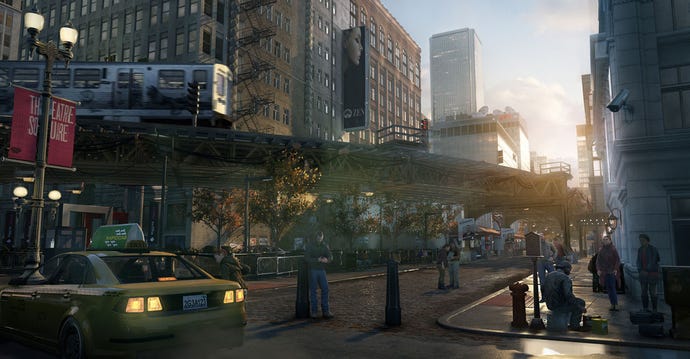Watch Dogs PS4 Review: Game of Phones
Ubisoft's Watch_Dogs was set to be a next generation launch title, but ended up being delayed at the very last moment. Is it worth the extra six-month wait? Oh yes. Oh yes indeed.
This article first appeared on USgamer, a partner publication of VG247. Some content, such as this article, has been migrated to VG247 for posterity after USgamer's closure - but it has not been edited or further vetted by the VG247 team.
Primary Reviewer, Jaz Rignall
I reached out for my thesaurus so I could start this review with a smorgasbord of superlatives, but decided not to because I didn't want to get all hyperbolic and peak early. All you need to know at this point is Ubisoft’s Watch_Dogs is really, really, holy [expletive] [expletive] good.
I’ve been playing it obsessively for days, and it’s taking every ounce of my self control not to abscond to my PS4 because, you know, there’s something I need to check. Actually, there probably is stuff I need to check, because Watch_Dogs is mind-bogglingly huge and I'm sure I've missed a few things. But this review must go on.
Oddly, though, despite Watch_Dogs being a big game, its map isn’t. It’s big enough, sure, but it’s nowhere near as big as its arch-rival GTA V. But what it lacks in size it makes up for in density. A veritable feast of toys, puzzles, games, missions and attractions are squeezed, singularity-style, into its scaled-down, 20-minutes-into-the-future, sandbox Chicago.
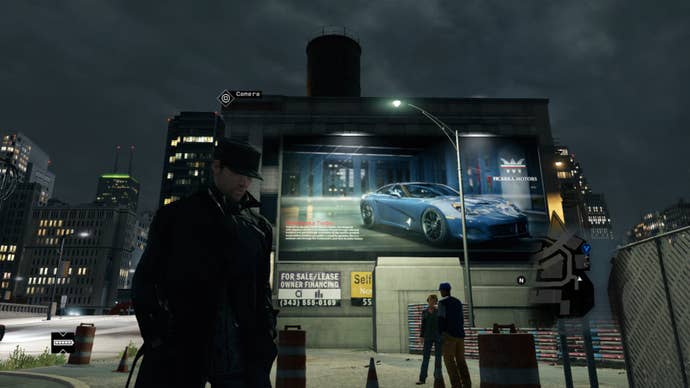
Plus, of course, the thing known as The Campaign - Watch_Dogs’ centerpiece that is its storyline. I’m not going to spoil it, and I’m barely going to tell you anything about it beyond what you very likely already know. Which is, in a Chicago of the very near future, ctOS – a Central Operating System - connects almost everything from utilities, ATM machines and CCTV cameras to public transport, webcams and even smartphones. Data from all these devices flows through a number of nerve centers spread across the city, where much of it is also stored - something that most people don't know.
Protagonist Aiden is able to exploit weaknesses in ctOS' security and use his smartphone to hack and interact with anything that is connected to it. Simply standing on a street corner can yield interesting results. Passers-by can be scanned and sometimes hacked so that Aiden can hear their conversations, read their texts or even steal money from their bank accounts. Sometimes interesting information can be gleaned, which can be acted upon or stored for later use.
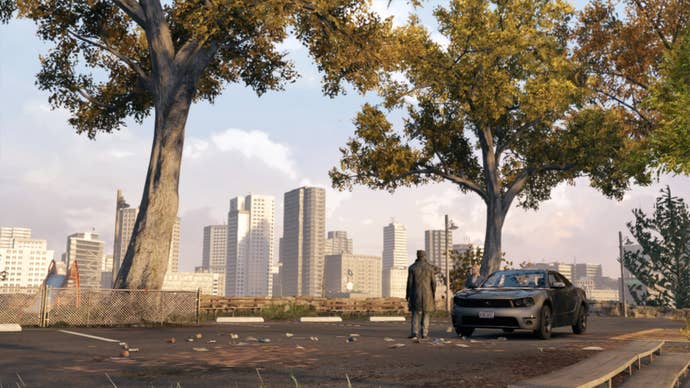
Hacking a CCTV camera enables Aiden to cast his field of hacking “view” even wider, and he can even jump from camera to camera to cover a wider area and perhaps locate other hackable targets. This mechanic is an integral part of the game, and one that gives it a very high degree of interest and originality.
Ultimately, the game’s premise essentially explores the concept of what happens when you have different people and organizations storing, accessing, controlling and using data to advance their own agendas – be they good, bad or indifferent. Aiden is one of them, though his agenda is mostly personal, with some opportunistic vigilantism when the chance arises. And arise it does - seemingly around every street corner.

At this point I’d like to change up the narrative with what probably feels like a bit of a non sequitur, but I think it’s relevant. A month or so ago, I attended a Watch_Dogs preview event. We played from the beginning of the game for a few hours, and were then boosted many hours into the game so we could play some of the later missions. I came away from the event impressed with the game, but not with the story or its characters. I found myself feeling detached, and not really caring about what I was doing or what was going on. That gave me a somewhat jaundiced view that I carried with me going into the full production copy.
However, I was delighted to find that the story and its characters are quite slow burn. Events unfold slowly, and it takes a while to warm up to the characters and to fully understand their motivations. That’s also my way of saying that you really do need to watch the cut scenes in this game. I find it surprising to hear myself say that, because I am one of the world’s worst offenders when it comes to X-button hammering, scene-skipping. But there are two reasons why it’s important to pay attention. Firstly, because the cut scenes play a critical role in driving the game – it really does feel arbitrary if you don’t understand the often much larger scope and ramifications that surround each mission. And secondly, because they’re exceptionally good on both a technical and a dramatic level.
Like most games, Watch_Dogs’ digital thespians suffer some uncanny valley-ness in the eye department, and the mouth syncing could have been better (it almost feels like the characters were motion captured for a foreign language first and then dubbed in English), but everything else is top class. The character modeling, clothing, and use of lighting all feel very next generation, and the mostly high quality voice acting and beautifully subtle motion capture really bring the characters to life.
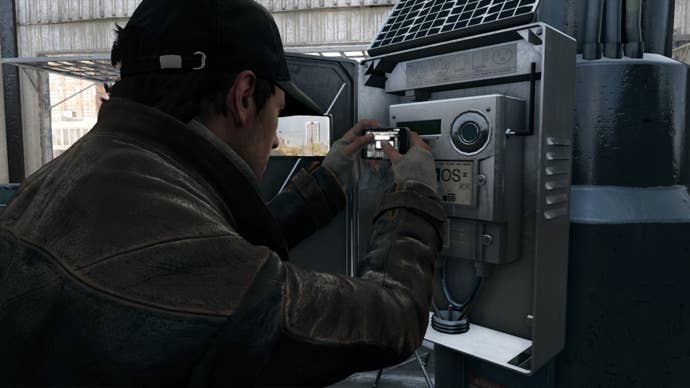
Apart from some occasional wooden dialog and flubbed lines, and a couple of situations where characters don’t seem quite true to themselves or their situation, Watch_Dogs does a terrific job in making you feel emotionally involved with its cast. This is something that very rarely happens with me: I tend to see cut scenes more as justification for what I’ve done or what I’m about to do. But in this game, they’re so much more than that. I’m interested to hear what the characters have to say, what their decisions and actions reveal about themselves, and how they relate to one another – which in this game runs the full emotional spectrum. In some cases, there’s even the hint of chemistry here and there – something that I think is a quite astonishing achievement for a game.
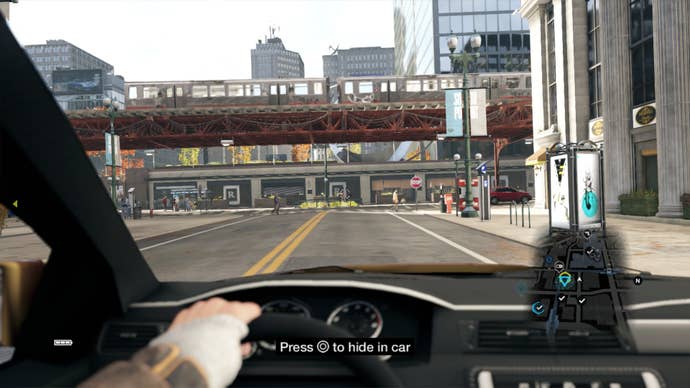
Surrounding the expansive and ambitious storyline is a myriad of missions and activites, and here’s where the game’s designers have really triumphed. One of my questions coming in to Watch_Dogs was whether or not it would be able to elevate the open world, guns-and-cars, story/mission structure that’s been milked nearly dry by generations of Grand Theft Auto games. Fortunately it does, and it does so very well.
There are plenty of standard fetch quests, shoot-outs, and automotive pursuits and evasions that wouldn’t look out of place in a GTA game. However, when missions factor in the game’s hacking component, a completely new dimension emerges that the designers have exploited very creatively, turning what could so easily have been a GTA knock-off into something richer and more intellectually challenging.
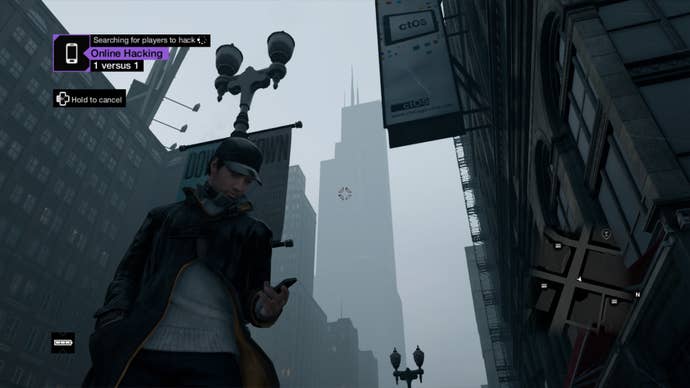
Many of the game’s larger mission set pieces are open and can be tackled in a wide variety of ways. Perhaps you might choose to shoot your way into a location using whichever SMGs, assault weapons, sniper rifles or spec ops gear you might have bought or acquired, and then shoot your way out. That’s pretty much always an option – and sometimes a viable one. But most of the time it’s difficult to pull off this brute force approach effectively.
So before you rush headlong in, perhaps you might want to hack a CCTV, and case the joint. In doing so, you might see some opportunities to trip a car alarm, or mess with pieces of machinery, which might cause certain guards to move away from their positions to investigate. As they do, you can then move in and make progress using the game’s cover and sneak mechanics without needing to fire a shot.
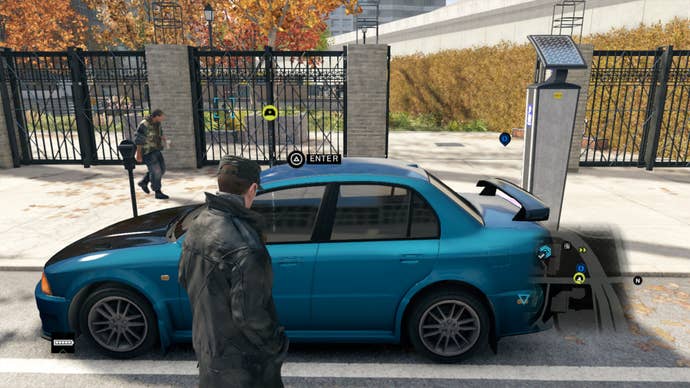
There are opportunities for even more deadly measures. Valves and control points on utility pipes can be hacked to cause them to rupture or even explode, blowing it – and any guards that happen to be nearby – to pieces. Aiden can also craft grenades, lures, and manually and proximity-detonated IEDs. This combination of a large cache of weapons, sneaking, and the ability to create distractions both benign and deadly give Aiden a very impressive tactical repertoire – and it’s this aspect of Watch_Dogs that I love the most. While some missions are linear, there is very, very rarely a single effective solution to achieve an objective. In most cases, it’s up to you to experiment with your own strategic approach, which is often incredibly fun and rewarding, because achieving an objective using your own creative solution is far more satisfying than simply figuring out the correct set of maneuvers that you need to execute to reach a goal.
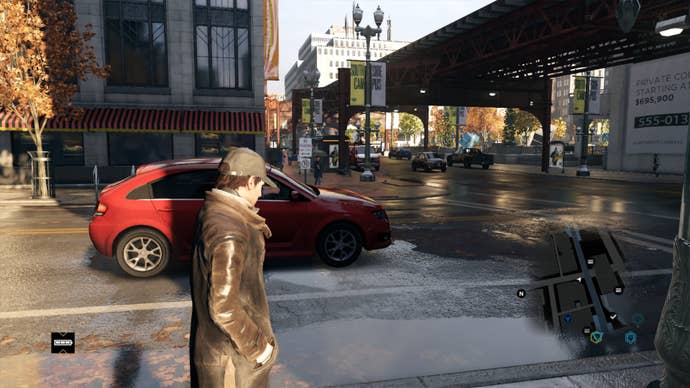
This openness is achieved thanks to some fairly solid AI, and the excellent design of mission locations that can vary from tight quarters to open areas with very little cover. Guards and enemies move around and use cover quite effectively, and even try to flank you. Sometimes they can be a little dumb, but considering most of the time you’re outnumbered, out-positioned and out-armored, this is not necessarily a bad thing. They react to what you’re doing in a reasonably consistent way, which means on repeated attempts at a particular mission, you can expect some degree of predictability. But that’s not always the case, and I found myself in more than a few situations where my well-laid plans just didn’t pan out the way I thought they would, and I ended up having to think very quickly on my feet and improvise. That can and does result in some the game's most exciting moments.
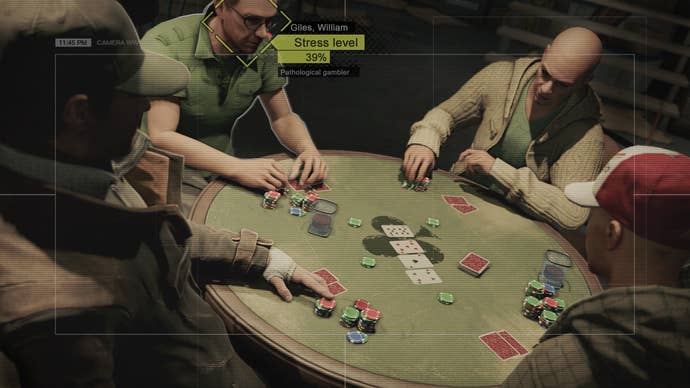
An interesting aspect of Watch_Dogs' sandbox-mission setup is that sometimes you can make things really hard for yourself, and sometimes the opposite can happen. On one mission, I hammered away at a particular approach before realizing that I was being an idiot, and by shimmying over a roof at the back of my target location and stealthing to a certain spot, I could easily take out the guards that were previously shooting me to pieces. Another time, I drove a car straight through the front gates and mowed down half the guards before they even knew what was happening, grabbed the objective, and drove straight back out in a hail of gunfire, escaping with the barest sliver of health. That was quite an adrenaline rush – one of many that Watch_Dogs has given me.
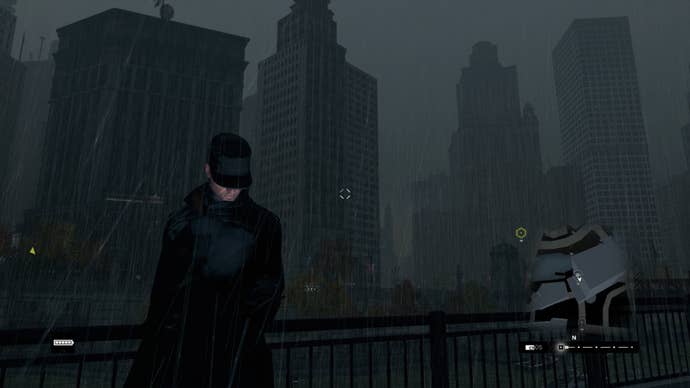
Something else I’ve enjoyed very much are Watch_Dogs’ environmental puzzles. Sometimes these play a part in a mission, but many are standalone side-missions that basically involve Aiden having to figure out how to reach a specific point on a building. Sometimes getting there is as simple as hacking a scissors elevator next to a nearby building and clambering over a roof. But most of the time they’re quite fiendish logic puzzles that involve using cameras to hack things, activate objects and find not-immediately-obvious objects to climb on so you can reach the objective.
Getting around Chicago is much as you’d expect: you can ride trains, or simply nab a handy car or motorcycle. However – and this is just me being a car nut – I tended to favor particular cars, because the ones in Watch_Dogs are based on real-life models, several of which are personal favorites (such as the Mitsubishi Evo VI clone). Auto-geeks will have a lot of fun playing spot the vehicle in this game: there are many of them, and some are really cool. It’s a minor deal, I know, but it’s something that really appealed to me. Especially since the game’s handling engine is pretty solid and effectively articulates a wide variety of steering characteristics, from oversteering classic muscle cars to fast-maneuvering super-minis. It just makes driving around fun.
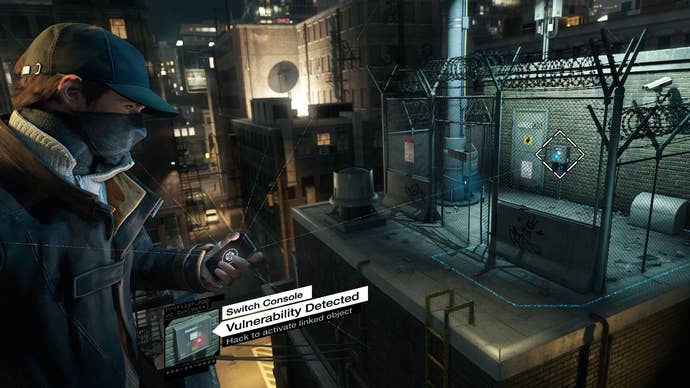
Cars can be used for racing, of course, and there are plenty of driving-specific missions and side missions too. These form a part of Watch_Dogs’ larger roster of things to do while you’re not working your way through the main campaign. It’s almost overwhelming at first, but once you begin to settle into the game it becomes easier to choose what you might want to do as a respite between major acts. Perhaps it might be dealing out some vigilante justice to street criminals or infiltrating a gang’s hideout to eliminate a specific individual, or perhaps it might be tailing a hacker, or uploading a backdoor to a target smartphone so data can be stolen.
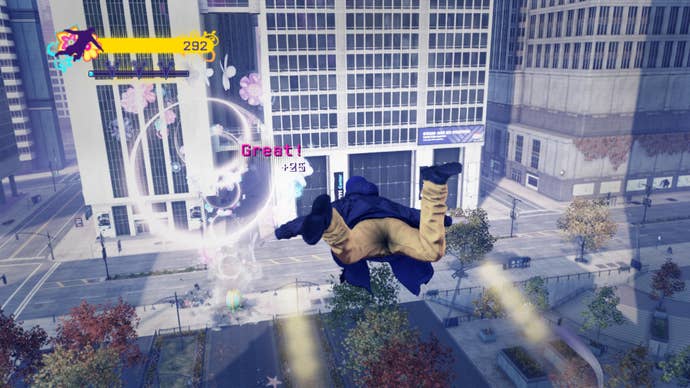
Or perhaps it might be time for some fun. Watch_Dogs features a number of different mini-games. For the more athletically minded, there are several Parkour-style challenges where you follow a trail as quickly as possible, for both a reward, and potential bragging rights on the online leaderboards. And then there are “Digital Trips,” often-outrageous psychedelic games that include a Carmageddon race where you mow down demonic policemen in a Chicago-style hell, or go on a crazy rampage in a Spider Tank – which is exactly what you think it is.
And if that isn’t enough, there’s a mini murder-mystery to solve, and a ton of other hidden things to find and collect. Oh, and there are also skills to develop that put more aces up Aiden’s sleeve, from improving his driving to making him more effective with weapons and hacking.
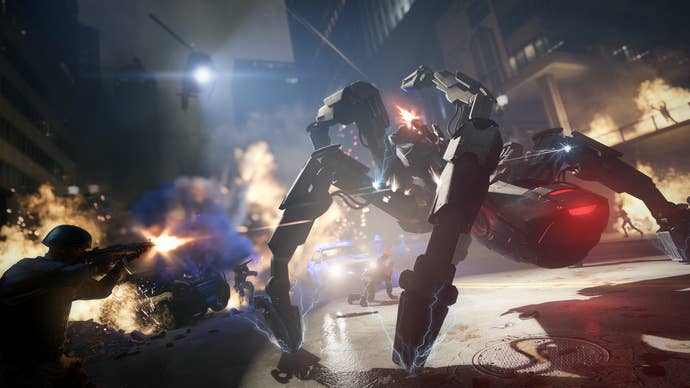
The sheer wealth of things to do makes Watch_Dogs a great place to spend time - time that you can also spend with friends. There are multiplayer racing, hacking and tailing games, although to be honest, they didn’t interest me a huge amount. Players can invade each others' games and steal data by following their opponent and avoid being spotted. However, it didn’t feel particularly skillful or fun to me – more a simple hide-and-seek game. The free-roaming option is probably the most entertaining aspect - basically it's a recipe for multiplayer combat chaos. It's fun, but I'm not sure of its long-term appeal, because it doesn't seem to be particularly well structured.
This is asking way too much, because it’s clear the developers already had their work cut out delivering Watch_Dogs in its current form, but I’d love to have seen options for two (or more) players to work together tactically on impregnable targets. Or perhaps one using CCTV cameras to help the other slip unseen through a heavily defended location - using the mechanics seen in several missions. That would have definitely been far more interesting than what’s on offer right now - but obviously a lot more work to produce.
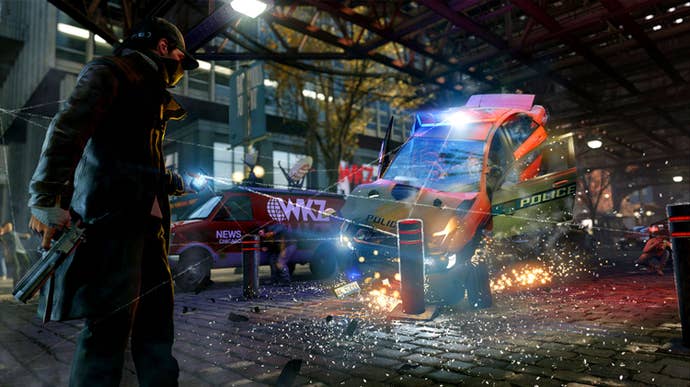
Something else I think could have been improved are the controls. The game is complex and Aiden can perform a multitude of tasks, but the button layout and wheel-style menus are sometimes clumsy, and make it difficult to activate an item or switch weapons quickly in the heat of battle. It’s something you can work around, but take it from me, prepare for some occasional moments when button confusion results in Aiden getting nailed.
Other nits to pick include the way music is integrated into the game – it isn’t presented radio-style, and just feels clunky. The lack of clothing options is another minor annoyance. Oh, and slightly better subtitle formatting would have been appreciated.
If you go out of your way, you can make pedestrians and drivers do stupid things or go into repetitive loops, and it's easy to create traffic chaos with one badly parked car – but for the most part, Watch_Dogs’ Chicago is a convincing, living, breathing city that’s alive with activity. The architectural attention to detail is phenomenal, the landscaping is stunning, and the lighting and environmental effects are just incredible. There will be moments where you’ll stop, look around and marvel at the sheer realism of it all. And if you don’t, do. Spend some time sightseeing, because near-obsessive care and attention has been put into this game’s environment, and it really should be appreciated. It’s in these details that you can witness what this new generation of consoles has in store for us.
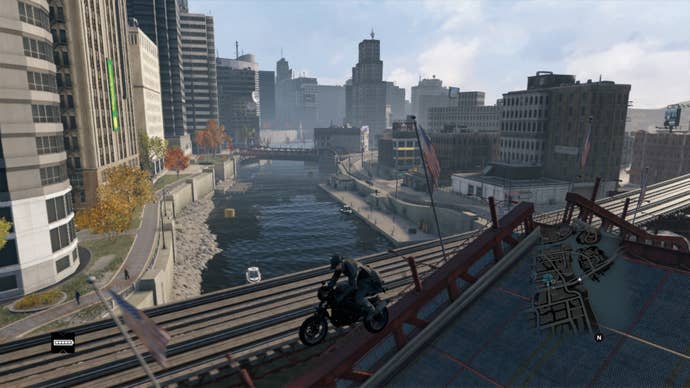
At this point, I don’t really know what more I can say. Watch_Dogs is a landmark, benchmark, must-buy game. It’s a challenging, rewarding, adrenaline pumping, utterly compelling spectacle that absolutely delivers on the sandbox premise by giving you a really interesting set of tools that you can use in whatever way you see fit to solve inventive, creative and exciting missions and objectives.
This is the next generation I’ve been looking for.
Second Opinion, Mike Williams
Watch Dogs is a surprising game that didn’t turn out like I expected it to. I expected Grand Theft Auto by Ubisoft, with a hacking twist to hook players. Yes, you could boil it down to just that, call it a day, and move on. Is Watch Dogs as good as Grand Theft Auto V? No, but that’s an unfair comparison, being that GTAV was Rockstar’s continuation of what they learned from the personally-disappointing Grand Theft Auto IV and Watch Dogs is the start of a new franchise for Ubisoft.
Watch Dogs brings together a few Ubisoft staples into a single title. There’s the open world and widget collect-a-thon the publisher mastered in developing the Assassin’s Creed series and Far Cry 3, the driving action of Driver: San Francisco, and a version of the character progression system created for Far Cry 3. What surprised me the most was the inclusion of gameplay from the Splinter Cell series, notably Conviction and Blacklist.
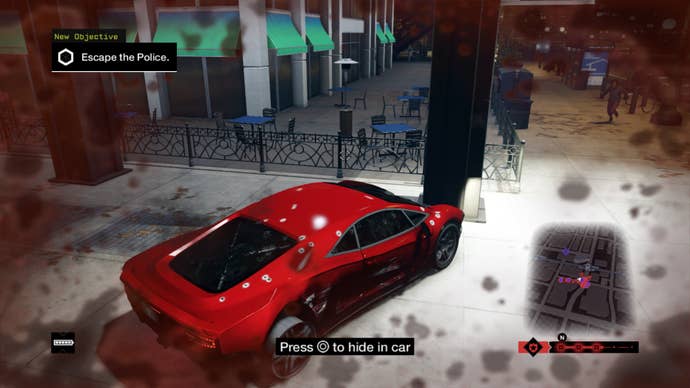
As Jaz explained, certain missions can be tackled in any number of ways, among them the randomly-generated Crime Preventions, the vehicle-themed Fixer Contracts, and the vigilante-style Criminal Convoys. While you can go in guns ablaze, Watch Dogs places stealth and planning before the run-and-gun in many story missions and the Gang Hideouts. Aiden, like Sam Fisher before him, can’t take that much sustained fire before blacking out.
The new hacking mechanic combines with Splinter Cell: Blacklist’s take on cover and stealth to create something different. Watch Dogs wants you to watch areas from far away, hacking into cameras to scope out the situation and choose your targets. Hacking can be used to disrupt communications, prevent enemies from calling out for reinforcements, provide distractions, and outright kill folks in certain cases. I found myself hiding behind corners, waiting for one guard’s back to turn before knocking out another. Throwing lures to get a rent-a-cop into the right position. Activating a grenade on an enemy to take out him and a comrade.
There’s a lot of stealth in Watch Dogs’ mission structure. Yes, sometimes I’d flub an approach, get spotted, and then clean up with my handy grenade launcher and Destroyer sniper rifle (seriously, unlock the Destroyer, it’s awesome), but most of the time I’d just reset the mission and try again. It’s the same gameplay loop I default to in any Splinter Cell title; being seen is failure. That’s something I really enjoyed about Watch Dogs that I didn’t expect to be there. And seeing how many missed the excellent Splinter Cell: Blacklist last year, I'm glad part of that stealth action will still reach audiences.
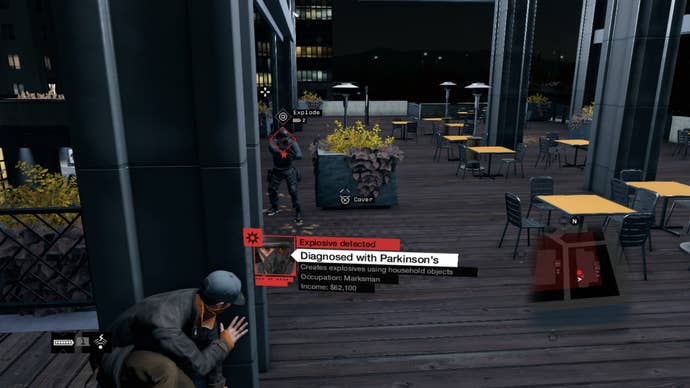
Watch Dogs is a Frankenstein's Monster built upon Ubisoft’s past successes. Jaz talked about the scope of the game and the wealth of things to do; it’s impressive, but not perfect. Your hacking abilities are locked behind skill trees. That would point towards focusing in specific directions, but doing the random missions that pop up will ensure that you’ll fill out most of the hacking skill tree early on. Once you get get the bread-and-butter moves - Steam Pipes and Bollard Control in my opinion - pursuit evasion becomes much easier.
Among the random missions - Ubisoft finally gets tailing right in Fixer Missions - you'll find the semi-frustrating Crime Prevention. In these missions, you’ll follow a victim or perpetrator within a marked area, staying out of their sight. Once the crimes happens, you intervene. Crime Prevention's problems involve timing. The amount of time you have to get out of sight if noticed is relatively short and half of the time you’ll approach the scene from the same direction the criminal is. You walk or drive into the zone, they notice you immediately, and bug out, ending the mission.
You also have to wait for the exact moment the crime happens before acting. Act too soon and the mission fails; the criminal isn’t a criminal yet, so you just shot a random person. Act too late, the victim dies, which is unsatisfying. I ended up relying on the time-slowing Focus mechanic in every single crime prevention, and even then the victim still died occasionally.
I understand why Ubisoft Montreal did this, because in the world of Watch Dogs, you’re the only person who knows about the crime before it happens. You can’t really bust someone for a crime they haven’t committed yet. And occasionally, the victim is a criminal as well, so why not let them die? It’s an interesting moral choice, but these missions overall aren’t tuned quite right. A bit more time to hide or intervene would’ve made them much more enjoyable. At some point I continued doing the missions just to raise my reputation, not because I liked them.
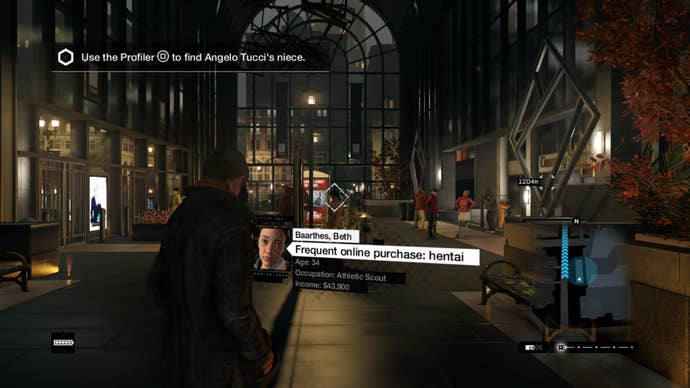
Watch Dogs has a number of these small problems. The hacking interface is well-done, giving you many options at the touch of a single button, but occasionally the option you want isn’t the one at hand. Focus seems a partial fix, letting you slow things down to target a specific hack, while the rest of the slack is taken up by the Neutralize feature that prioritizes hacks that will hurt pursuers. The smartphone menu interface feels slow and it never quite clicked with me. A similar complaint can be lobbed at the weapon interface. Again, all these features work, they’re not just as good as they could be.
Watch Dogs is a very good game. It has a lot to do and will keep you occupied for a long while, but it still falls short of my all-time best, Sleeping Dogs. That title was probably one of my favorite open-world shooting/driving games ever because it’s so small and tight. Watch Dogs and other open-world titles like GTAV creak under the weight of giving the player so many things to do, which can come at the expense of focus. Sometimes, I’d just open the map in Watch Dogs and marvel at all of the different Check-Ins, Digital Trips, City Games, Fixer Contracts, Gang Hideouts, Investigations, and AR Phone Games available; other times just seeing it all would tire me out.
Watch Dogs reminds me of the first Assassin’s Creed; an impressive piece of work with a few problems and a host of potential ahead of it. The jump from Assassin’s Creed to Assassin’s Creed II was nothing short of astounding and I’m hoping the jump from Watch Dogs to Watch Dogs II is just as good. Until then, Watch Dogs is still worth a purchase.
The Nitty Gritty
- Visuals: Whether it's the realistic textures of a character's clothing, or the garbage in a dark back alley, Watch_Dogs' world, characters and vehicles are astonishingly well conceived.
- Music: The ambient sound is superbly detailed and realistic, and the voice acting is excellent. The music feels a little arbitrary, good though much of it is.
- Interface: The controls can sometimes be fiddly, simply because this is such a complex game, but generally Watch_Dogs does a good job in enabling the player to effectively work through its broad range of options.
- Lasting Appeal: Once you finish the meaty and often challenging campaign, there are plenty of other things to do. And if you like the multiplayer options, that'll further extend the life you can wring from this.
ConclusionWatch_Dogs combines an astonishingly detailed world, a gripping storyline, creative game mechanics, a myriad of missions and activities, and improvisational tactical sandbox gameplay to create a truly next-generation open world game. Phenomenal. No other word for it.
